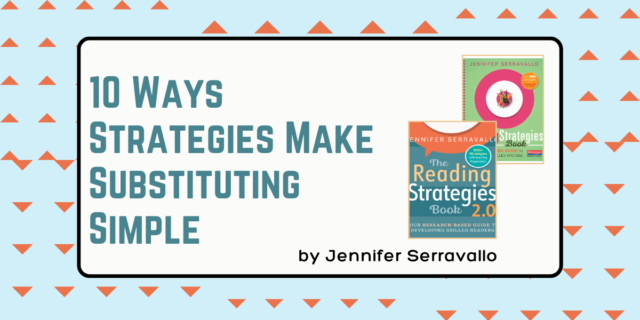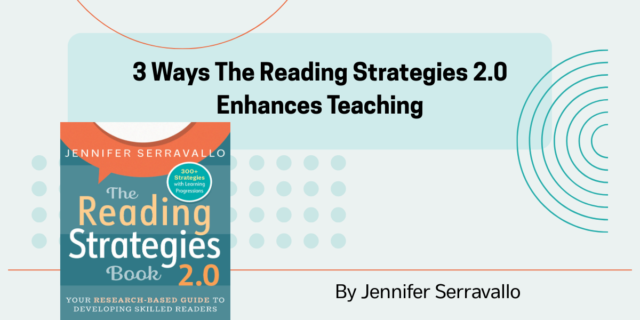
The following has been adapted from Jennifer Serravallo's intro to It's All About the Books by Tammy Mulligan and Clare Landrigan.
The following has been adapted from Jennifer Serravallo's intro to It's All About the Books by Tammy Mulligan and Clare Landrigan.
From Tulsa to Tallahassee, Greenwood to Great Neck, Los Angeles to Louisiana, I’m often asked: How can we make sure all of our students become skilled, engaged readers? When I visit Ohio, there’s conversation about the “Third Grade Guarantee”; in Marin County it’s the “Third Grade Promise”: All kids must be reading at or beyond the proficient level by the middle of elementary school. In many of the diverse districts in which I work, administrators are rightly concerned about achievement gaps based on income level, race, English language proficiency, etc. In many cases, districts scramble for a “fix” that will help all the problems go away. Some purchase costly computerized progress-monitoring software. Others spend a fortune on programs and kits, and the snazziest technology.
But what if the solution was simpler—less flashy, but so much more exciting?
It is.
Schools need books and skilled, passionate teachers who know how to put those books into the hands of readers and help them to engage with meaningful reading. When Tammy and Clare begin consulting work in new schools, they find themselves saying: “Fire us and buy books,” because they know that access to an inclusive collection of high quality books and texts that students can and want to read is one of the most significant equity issues schools face.
I’ve consulted in districts where many parents don’t have a car, or who work multiple jobs, and physically can’t get to the town’s library. I taught in a school where undocumented parents were afraid to provide personal information needed to get a library card for themselves or their children. I’ve lived in towns where budget cuts meant shutting library doors except for a very few hours each week, and where school librarian positions were eliminated. I know for a fact that most bookstores don’t carry the kinds of predictable texts our emergent readers need in kindergarten and early first grade, and even if parents can afford to purchase them, they aren’t available. Schools must provide books for in-school and at-home reading.
Do the math: If a second-grader reads for a half hour or more each day in school and more at home, and it takes that student about an hour to finish a book, that means that one student will go through a stack of books each week. Multiply that stack by hundreds of students in the school and it soon becomes clear that schools need a lot of books. And not just any books—good ones. And then once they start arriving at the school, we need to organize them. And make sure kids are finding the right ones. And, and, and….
Never fear—Tammy and Clare to the rescue! This book will help you stock your school with books, on a budget—no matter what your school’s budget is. Unless you have thousands of books in every classroom; a well-stocked school library; a bookroom where books are in constant circulation and not just collecting dust; a school full of children who all know how to choose books they’ll love; teachers who know how to set up and organize their libraries so it suits their class, you need to hear their advice. Tammy and Clare offer us endless insider tips to make every dollar count, make the most use of digital resources available, and help teachers manage the huge job of what to do with the books once they arrive.
This book is practical, but it’s also inspirational. It’s clear that kids are at the heart of everything Tammy and Clare do and the pages brim with student voices: their worries, their excitement, their stories about how they are building reading lives and sharing books with others. It’s also filled with teachers: we listen in as teachers interact with students around books, make recommendations, encourage students as they talk about their wishes and goals for themselves as readers, and guide them to find the books they’ll love.
In this book, Tammy and Clare show us that classroom libraries and book¬rooms are more than just storage places—they should be dynamic and kinetic. They show us that books are more than materials—they are the lifeblood of our classrooms.
Tammy and Clare have given us a book about books. What could be better?
•••
To learn more about It's All About the Books, visit heinemann.com, and click below to download a sample chapter!

Jennifer Serravallo is the author of the New York Times bestseller The Reading Strategies Book and The Writing Strategies Book, which have been translated into Spanish, French, and Chinese. These and her other popular books and resources help teachers make goal-directed responsive strategy instruction, conferring, and small group work doable in every classroom. Her newest titles are Teaching Writing in Small Groups, A Teacher’s Guide to Reading Conferences, Understanding Texts and Readers, and the assessment and teaching resource Complete Comprehension for Fiction and Nonfiction.
Jen is a frequently invited speaker at national and regional conferences and travels throughout the US and Canada to provide full-day workshops and to work with teachers and students in classrooms. She is also an experienced online educator who regularly offers live webinar series and full-day online workshops, and is the creator of two self-paced asynchronous online courses, most recently Strategies in Action: Reading and Writing Methods and Content.
Jen began her career in education as an NYC public school teacher. Now as a consultant, she has spent the last fifteen+ years helping teachers across the country create literacy classrooms where students are joyfully engaged, and the instruction is meaningfully individualized to students' goals. Jen is also a member of Parents Magazine Board of Advisors for education and literacy.
Jen holds a BA from Vassar College and an MA from Teachers College, where she has also taught graduate and undergraduate classes.
Learn more about Jen and her work at Hein.pub/serravallo, on Twitter @jserravallo, on Instagram @jenniferserravallo, or by joining The Reading and Writing Strategies Facebook Community.


